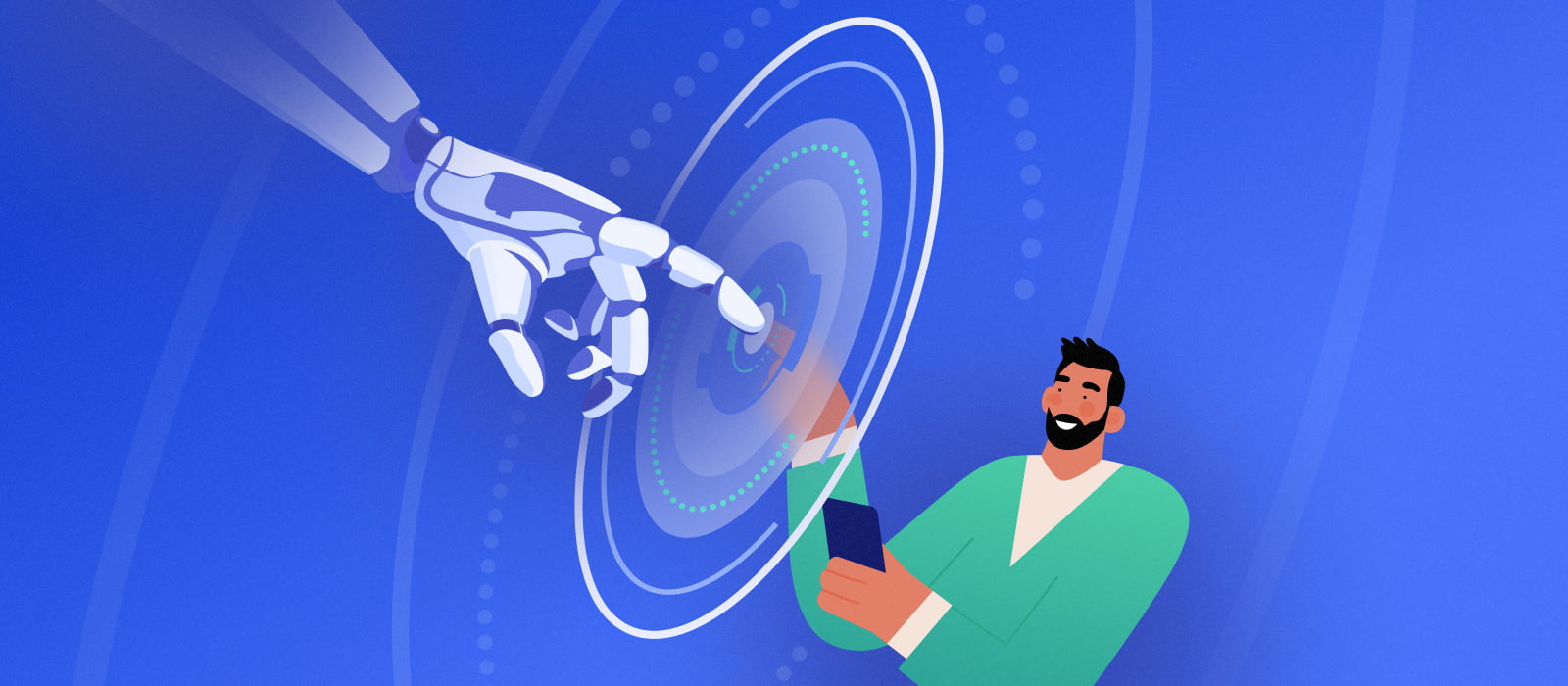Digital transformation (DX) integrates digital technologies into all areas of an organization to enhance current operational processes and develop new ones — while providing greater utility to consumers. But how is it redefining business value?
The numbers are interesting: digital transformation spending is predicted to reach $1,8 trillion by 2022 and to grow even faster after that, with forecasts exceeding $2,8 trillion by 2025.
Despite the economic downturn brought on by the Covid-19 outbreak, companies’ efforts to adapt digitally have mostly begun and have been expanding since the start of the pandemic. And even though correlation does not imply causation, the pandemic has significantly accelerated digital transformation, putting the emphasis on more agile and intelligent ways of doing business.
Notably, while in 2018 digitally transformed enterprises accounted for $13,5 trillion of the global nominal GDP, in 2023 they are expected to account for $53,3 trillion.
What is digital transformation?
![]()
Digital transformation describes the business process of transitioning to digital systems for efficiency, scalability and cost-effectiveness. This process could translate into the shift of obsolete systems to third-party digital solutions that make these systems work more efficiently.
However, digital transformation generally requires a degree of restructuring for enhanced business operations. Some examples of this restructuring might include:
- System migration to the cloud
- Making the switch to advanced telecommunications
- Integrating machine learning
Beyond this, it also involves a cultural change, with businesses needing to challenge the status quo, discard long-standing company processes in favor of new and undefined ones, and accept failure in the name of innovation.
Why is digital transformation important?
An organization may embark on digital transformation for a variety of reasons. However, the risk of being left behind is an especially compelling motivation. In the aftermath of the pandemic, the capacity to quickly adjust to supply chain disruptions, time-to-market pressures, and customer expectations has become essential.
Similarly, an IT spending survey of 501 IT executives worldwide suggests that leaders recognize digital transformation as a prerequisite for competing in today’s market and a strategy for long-term success. For 75% of survey respondents it’s their top priority, followed by cybersecurity (73%), and cloud migration (65%).
On the practical side, organizations stand to benefit from digital transformation in a variety of ways. Among these are:
- Increased efficiency
- Lower costs and a higher ROI
- Improved network infrastructure
- Modern architectures and business models
- Increased potential for data visualization
Want to enable digital transformation in your business vertical? Then check out our blog page dedicated specifically to digital transformation
Top 10 digital transformation trends
As digital technology is an ever-developing field, it’s not always easy to predict which changes will endure and which will fade away. Certain trends, though, seem to be shaping the future of the field. So let’s take a closer look.
![]()
1. Blockchain
Blockchain technology has become a significant trend in digital transformation due to its unique architecture. At its core, blockchain is a decentralized ledger that records transactions across multiple computers in a way that ensures security, transparency, and immutability. The decentralized structure, combined with cryptographic procedures, ensures that no information in the database can be secretly manipulated.
Industries such as finance, supply chain, healthcare, and even government services are exploring blockchain to enhance security, reduce fraud, streamline operations, and improve transparency in their processes.
For example, companies like Walmart and Maersk are using blockchain to track the production, shipment, and receipt of products in their supply chains. This technology ensures the authenticity of products, reduces counterfeiting, and improves transparency.
In real estate, the technology can be used for recording, tracking, and transferring land titles and property records, reducing fraud, and speeding up transactions.
Banks are using blockchain for improved security and efficiency in transactions. For instance, JPMorgan is using blockchain to improve funds transfers.
Searching for a reliable blockchain service provider that can help you move your business to a new level? We got you covered
2. Data protection & Zero-Trust security
A Gallup survey revealed that 54% of employees who work remotely report that they prefer to split their time between working at home and working in the office, thus creating a hybrid arrangement. And as many organizations have adopted this hybrid or remote setup, the risk of cyberattacks has increased.
AI threat detection technologies, better encryption methods, and embedded system security are just a few technologies companies use to safeguard their critical information. However, to be resilient, zero-trust security must be introduced. Zero-Trust is a security model built on the notion of strict access controls and a resolve not to trust anyone by default, including those already inside the network perimeter.
Companies are already planning and implementing the transition to cloud-based, zero-trust security architecture. The new security solution will assist in the establishment of trust, authority, brand reputation, and the inception of secure B2B communications. And the way to do this is by:
- requiring secure and authenticated access to all resources
- adopting a ‘least privilege’ model and enforcing access control
- inspecting and logging all activities using data security analytics
Explore the most prominent cybersecurity trends to keep an eye on in 2025
3. 5G & IoT
Multi-peak data speeds, low latency, improved user experience, better connectivity and availability, and increased network bandwidth are among the primary characteristics of 5G technology. Increasing numbers of networks and devices are already transitioning to 5G to facilitate the expanded demand for faster connectivity. But there is more to 5G than this.
Technologies like AI, drone-initiated inspections, and video inspections will automate daily operations while avoiding network issues. Meanwhile, 5G use cases in the IoT development domain include:
- Remote patient monitoring: 5G connectivity will allow for smooth remote patient monitoring. What’s more, health professionals can provide assistance anytime and from any location.
- Connected automobiles: The low latency and high bandwidth of 5G will enable cars to store and initiate bi-directional communication.
- Shipping and logistics: Accurate tracking of shipped items; This will enable the updating of specific delivery timeframes, improving customer experience.
4. Generative AI
Generative AI stands out as a transformative trend in digital transformation. Forrester, for example, states that more than 25% of AI decision-makers worldwide predict that 51% to 75% of their workforce will be employing generative AI technology by the end of 2025.
It is redefining content creation and ideation processes across various sectors. In fields like marketing, generative AI is used to create personalized advertising content, while in software development, it aids in generating code, accelerating development cycles. The entertainment industry sees its application in creating unique music and artwork.
Moreover, this technology’s potential in generating realistic simulations and models is proving invaluable in research and development services, facilitating advancements in fields like pharmaceuticals and environmental science.
Explore the most recent AI stats and trends across multiple categories
5. Hyperautomation
Hyperautomation uses artificial intelligence, machine learning, and robotic process automation (RPA) to analyze and manage IT and business processes. The tools operate with structured and unstructured data to provide businesses with actionable insights. By automating repetitive tasks and streamlining complex workflows, hyperautomation significantly reduces operational costs and increases productivity. It also enhances decision-making by delivering real-time data analysis, allowing companies to quickly respond to emerging trends and challenges. Partnering with an experienced AI development company can help businesses implement hyperautomation solutions effectively, ensuring they maximize the benefits of advanced technologies in their operations.
RPA handles repetitive work tasks using software robots. As a result, RPA can provide in-depth observations of background processes that companies would otherwise not be able to identify. This way, businesses can bring their data-driven decisions to the next level and improve their operational capacities.
6. Everything as a service
Everything-as-a-Service, also known as Anything-as-a-Service (XaaS), is the latest digital transformation trend that pushes the “as-a-service” model. XaaS extends the basic cloud service concept by including additional services such as:
- Security as a Service (SECaaS)
- Function as a Service (FaaS)
- Unified Communication as a Service (UCaaS)
- Video as a Service (VaaS)
- Storage as a Service (STaaS)
- Containers as a Service (CaaS)
XaaS also paves the way for “Servitization,” providing a combination of products and services in a single package. Amazon’s Alexa, which offers AI-driven services alongside portable hardware items, is a simplified example of servitization.
The most recent real-world example of XaaS is a collaboration between Hewlett Packard Enterprise (HPE) and Veeam. The joint HPE GreenLake and Veeam offering provides customers with a robust “as-a-service” experience.
The platform matches customers’ evolving demand for the cloud experience. It also enables enterprises to streamline their data transformation strategy with the safeguards of backup and replication. With their partnership in place, Veeam and HPE seek to keep data secure irrespective of where you store it, on or off-premise.
7. Cloud
Companies are shifting their focus away from on-premise data centers and toward cloud services, thereby helping to accelerate the organizations’ digital transformation.
Cloud computing is being used by businesses of all sizes and industries for a range of purposes, including data backup, disaster recovery, email, virtual desktops, software development and testing, big data analytics, and customer-facing web apps.
Cloud computing is significant for several reasons:
- The need for vital information to be stored on paper has been dramatically reduced — as has the carbon footprint.
- Cloud computing enables remote work. This method of storing and retrieving company data was especially beneficial during the Covid-19 pandemic; but as discussed earlier, remote work is going to remain a fixture.
- Over the last two years, businesses have increasingly used a combination of public and private clouds to mitigate the cyber risks associated with employees accessing business networks from home.
- Last but not least, new prospects for a more efficient analysis of customer behavior have emerged by enabling the storage of large amounts of data in a single location.
8. Data fabric
Data fabric is an integrated layer (fabric) of data and connecting processes. It leverages human and machine capabilities to access the data in place or to support its consolidation where appropriate. It continuously identifies and connects data from disparate applications to discover unique, business-relevant relationships between the available data points.
In this interesting analogy, we’re asked to consider two scenarios.
In the first, the driver is active and focuses on the path, and the car’s autonomous element intervenes slightly. In the second, the driver is lazy and loses focus, and the car shifts to semi-autonomous mode and makes course corrections.
Both instances encapsulate how data fabric works. It monitors the data pipelines as a passive observer and suggests more effective options. When the data “driver” and the machine learning are comfortable with recurring scenarios, they complement each other by automating improvisational tasks that usually take too many manual hours, allowing the leadership to focus on innovation.
9. Data-driven business
Another prominent digital transformation trend is data-driven decision-making.
In 2024 and 2025, data analytics and big data have become essential in driving business strategies and operations. These technologies enable companies to extract insights from vast datasets, improving decision-making and understanding customer behavior.
For instance, in retail, giants like Amazon and Walmart utilize big data to analyze consumer purchasing patterns, optimizing inventory and personalizing shopping experiences.
In healthcare, data analytics is crucial for patient care, helping hospitals identify disease trends, improve diagnostics, and tailor treatments.
Financial institutions leverage big data for risk assessment, fraud detection, and personalized financial services.
10. Low-code, no-code platforms
Catering to the need for rapid and efficient software development, low-code and no-code platforms have emerged as a significant trend in digital transformation. These platforms enable business users to create applications using drag-and-drop components and model-driven logic.
Businesses of all sizes are adopting these platforms to quickly develop solutions for a range of needs, from internal process automation to customer-facing applications, without the lengthy timelines traditionally associated with software development.
The impact of low-code and no-code platforms extends beyond just simplifying software creation. They empower business users, including analysts and managers, to directly contribute to digital solutions, thus creating a culture of agility within organizations.
Closing thoughts
Today’s organizations are in different places on the road to digital transformation, but as the demand shock resulting from the pandemic demonstrated, the digital transformation era has arrived and is here to stay. To remain competitive in this rapidly changing landscape, organizations must quickly adapt their strategies and welcome the fact that “business as usual” is no longer an option.
However, one of the most challenging questions is how to shift from vision to execution. And that is why you need PixelPlex’s digital transformation services to embark on this journey alongside you. With blockchain, AI, ML, and big data among our signature techs, we can guide you along a smooth and iterative pathway, helping you enable digital transformation.




